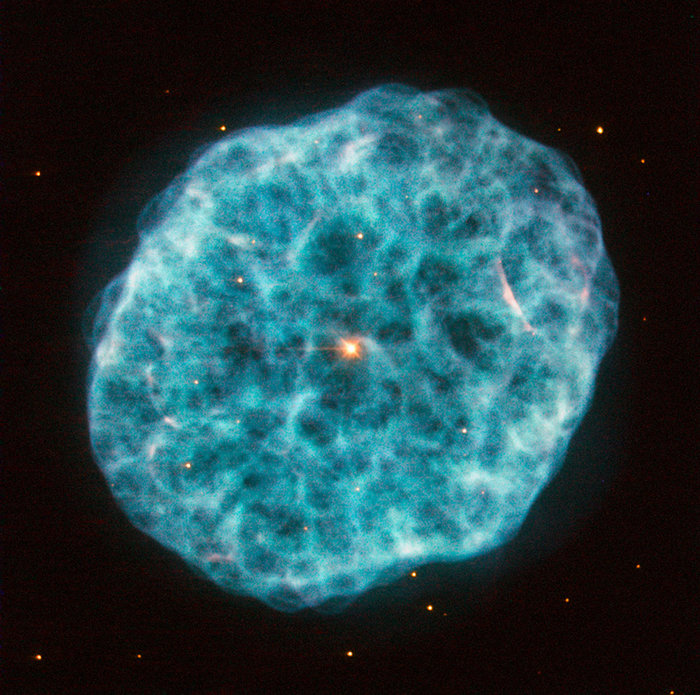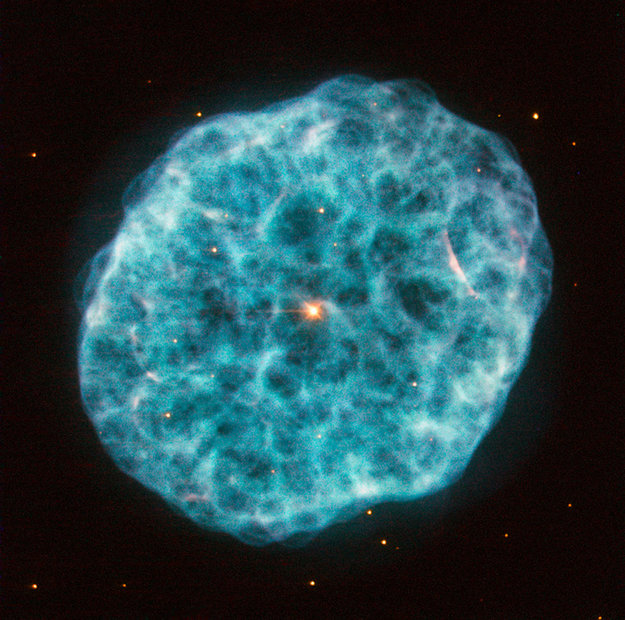http://www.esa.int/spaceinimages/Images/2016/09/Hubble_views_a_cosmic_oyster_and_pearl_in_NGC_1501
El mundo es su ostra, como se dice - y el / ESA Hubble de la NASA, con sus instrumentos avanzados y favorable posición en órbita sobre la atmósfera de la Tierra, tiene mucho más del Universo para explorar que la mayoría..............
Hubble views a cosmic oyster and pearl in NGC 1501

Details
- Title Hubble views a cosmic oyster and pearl in NGC 1501
- Released 07/09/2016 10:17 am
- Copyright ESA/Hubble & NASA; acknowledgement: M. Canale
- Description The world is your oyster, as the expression goes – and the NASA/ESA Hubble Space Telescope, with its advanced instruments and favourable location in orbit above Earth’s atmosphere, has far more of the Universe to explore than most.
This image was captured using Hubble’s Wide Field Planetary Camera 2, the camera responsible for many of the telescope’s most beautiful images. It shows the appropriately nicknamed Oyster Nebula (more formally known as NGC 1501), a candescent cloud some 5000 light-years away from Earth in the constellation of Camelopardalis.
The Oyster Nebula is a type of cosmic object that is essentially a giant cloud of dust and electrically charged gases. Nebulas are often made to glow, as seen here, by the radiation from a nearby star. In the case of the Oyster Nebula, that star can be seen as a yellow–orange dot at the centre of the turquoise cloud, resembling the oyster’s precious pearl.
This is a planetary nebula, meaning that it was created when its progenitor star – the ‘pearl’ – threw its outer layers of gas into space. This star is just as notable as the beautiful structure surrounding it. It is a pulsating star, meaning that its brightness varies regularly and periodically. In the case of NGC 1501’s progenitor star, this is incredibly fast, with the star’s brightness changing significantly in just half an hour.
The complexity of the Oyster Nebula’s internal structure is clearly evident in this detailed image, appearing almost webbed or bubbly. Astronomers have modelled this object in 3D and found it to be an irregularly shaped cloud filled with lumpy and bumpy structures, such as knots and bubbles of gas and clumps of dust, all knitted together.
These visible-light observations capture the glow of gases including hydrogen and nitrogen. The bright colours shown here are arbitrary. A version of this image was entered into the 2012 Hubble’s Hidden Treasures image processing competition by contestant Marc Canale.- Id 364772
TAGS
VERSIÓN EN ESPAÑOL :
Una ostra cósmica, con su perla, en NGC 1501
8 septiembre 2016
El telescopio espacial Hubble de la NASA/ESA, con sus avanzados instrumentos y desde su órbita sobre la atmósfera terrestre, se encuentra en una posición privilegiada para explorar el Universo y descubrir los tesoros que esconde.
Uno de esos tesoros es esta fotografía tomada con la Cámara Planetaria y de Gran Angular 2 de Hubble, responsable de muchas de las más bellas imágenes que nos brinda el telescopio. Muestra la conocida como Nebulosa de la Ostra (o NGC 1501, su nombre oficial), una nube incandescente a unos 5.000 años luz de la Tierra, en la constelación de Camelopardalis (La Jirafa).
Esta nebulosa es un tipo de objeto cósmico formado básicamente por una gigantesca nube de polvo y gases cargados eléctricamente. Las nebulosas suelen brillar, como vemos aquí, por la radiación de una estrella cercana. En el caso de la Nebulosa de la Ostra, la estrella se ve como un punto anaranjado en el centro de la nube turquesa, similar a una perla en el interior de una ostra.
Se trata de una nebulosa planetaria; es decir, se creó cuando su estrella progenitora —la ‘perla’— expulsó sus capas externas de gas al espacio. La estrella, tan espectacular como la estructura que la rodea, es de tipo pulsante: su brillo varía de forma regular y periódica. En el caso de la estrella progenitora de NGC 1501, el ritmo es increíblemente rápido, dado que su brillo cambia significativamente en tan solo media hora.
La complejidad de la estructura interna de la Nebulosa de la Ostra resulta evidente en esta imagen detallada, en la que la estrella casi parece estar rodeada por una tela de araña o una burbuja. Los astrónomos han modelado este objeto en 3D, descubriendo que se trata de una estrella de forma irregular, llena de estructuras grumosas y abultadas, como nodos y burbujas de gas y aglomeraciones de polvo, todos ellos fuertemente entrelazados.
Las observaciones en luz visible capturan el brillo de los gases, incluyendo hidrógeno y nitrógeno. Los brillantes colores mostrados en esta imagen son arbitrarios. Una versión de esta imagen fue enviada por Marc Canale al concurso de procesamiento de imágenes Tesoros ocultos del Hubble en 2012.
Guillermo Gonzalo Sánchez Achutegui
ayabaca@gmail.com
ayabaca@hotmail.com
ayabaca@yahoo.com
Inscríbete en el Foro del blog y participa : A Vuelo De Un Quinde - El Foro!


No hay comentarios:
Publicar un comentario